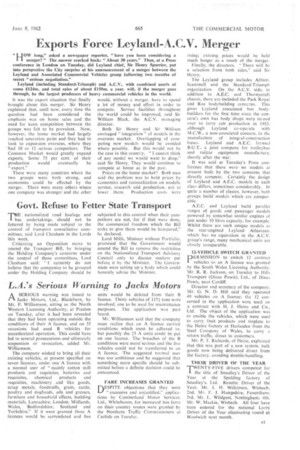Exports Force Leyland-A.C.V. Merger
Page 27

If you've noticed an error in this article please click here to report it so we can fix it.
" HOW long," asked a newspaper reporter, "have you been considering a merger?" The answer cracked back: "About 30 years." Thus, at a Press conference in London on Tuesday, did Leyland chief, Sir Henry Spurrier, put into perspective the City surprise at his announcement of a merger between the Leyland and Associated Commercial Vehicles group following two months of secret "serious negotiation."
Leyland (including Standard-Triumph) and A.C.V., with combined assets of some £124m. and total sales of about £150m. a year, will, if the merger goes through, be the largest producers of heavy commercial vehicles in the world.
It was the export situation that finally . brought about this merger. Sir Henry explained that, until now, every time the question had been considered the emphasis was on home sales and the need for keen competition between the groups was felt to be prevalent. Now, however, the home market had largely reached saturation point anti they hail to look to expansion overseas, where they "had 10 or 12 serious competitors. The Common Market would greatly expand exports. Some 75 per cent, of their production would eventually be " export."
There were many countries where the two groups were both strong, and economies could be effected by the merger. There were many others where one company was stronger and the other
would, without a merger, have to spend a lot of money and effort in order to compete. Service facilities throughout the world could be improved, said Sir William Black, the A.C.V. managing director.
Both Sir Henry and Sir William envisaged integration" of models in the overseas market. Overlapping of competing new models would be avoided where possible. But this would not he the case in this country. " I cannot think of any model we would want to drop," said Sir Henry. They would continue to compete at home as in the past.
Prices on the home market? Both men said the problem was to hold prices by economies and rationalization on models. service, research arid production, not to lower • them. Production costs were rising; existing prices would he held much longer as a result of the merger.
Finally, the directors. "There will be a selection from both sides," said Sir Henry.
The Leyland group includes Albion. Scammell and the Standard-Triumph organization. On the A.C.V. side, in addition to A.E.C. and Thornycroft chassis, there are included the Park Royal and Roe bodybuilding concerns. This gives Leyland associated bus bodybuilders for the first time since the concern's own bus body shops were turned over to lorry cab production in 1953. although Leyland co-operate with M.C.W., a non-associated concern, in the manufacture ,of integral-construction buses. Leyland and A.E.C. formed B.U.T., a joint company for trolleybus and railcar equipment manufacture. shortly after the war.
It was said at Tuesday's Press conference that there were no models at present built by the two concerns that directly compete: Certainly the design of Leyland and A.E.C. Models in each class differs, sometimes considerably, In quite a number of classes, however, both groups btiild models which are comparable.
A.E.C. and Leyland build parallel ranges of goods and passenger models powered by somewhat similar engines of just under 10 litres capacity, for example. Whilst there are such unique models as the rear-cngined Leyland Atlantean, which has no equivalent in the A.C.V. group's range, many mechanical units arc closely comparable:
12-VEHICLE SWITCH GRANTED
PERMISSION to switch 12 contract vehicles to an A licence was granted by the South Wales Licensing Authority. Mr. R. R. Jackson, on Tuesday to Hills Transport (Dinas Powis), Ltd., of Dinas Powis, near Cardiff.
Director and secretary of the company. Mr. G. N. D. Hill said they operated 49 vehicles on A licence; the 12 concerned in the application were used on a contract with H. J. Heinz and Co., Ltd. The object of the application was to enable the vehicles, which were used to carry fruit products and tinplate to the Heinz factory at Harlesden from the Steel Company of Wales, to carry a return traffic, direct to customers.
Mr. P. T. Richards, of Heinz, explained that this was part of a new system, bulk goods now being delivered direct from the factory, avoiding double-handling.
THEIR DRIVER OF THE YEAR TWENTY-FIVE drivers competed for l• the title of Smedley's Driver of the Year at the Spalding factory of Smedley's, Ltd. Results: Driver of the Year. Mr. J. H. Wilkinson, WiSbech; 2nd, Mr. F. J. Hampshire, Faversham; 3rd, Mr. L. Wildgust, Nottingham; •4th. Mr. W. Mackie, Wisbech. All four have been entered for the national Lorry Driver of the Year eliminating round at Woolwich next month.




































































































